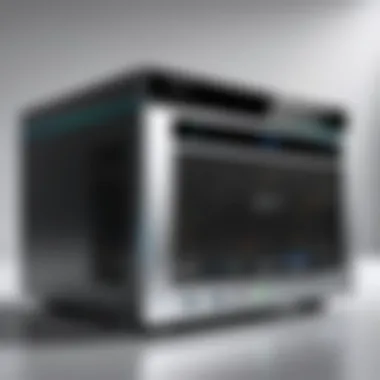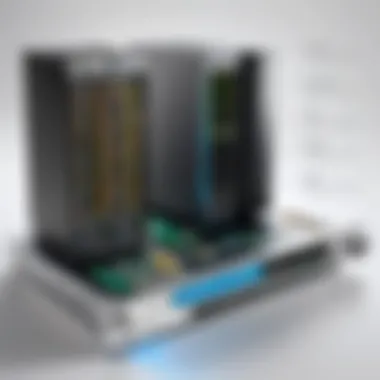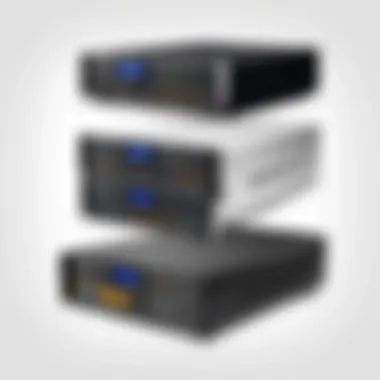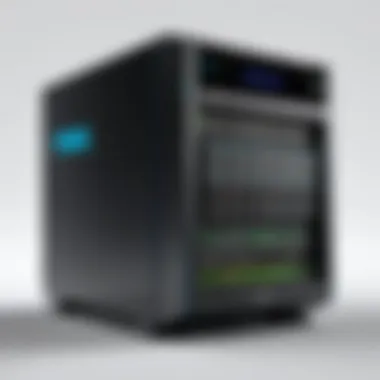Top NAS Solutions for an Ultimate Home Media Server


Intro
In the age of digital information, a reliable media server at home is not just a luxury but a necessity for many users. With the growing demand for high-quality video streaming, large media libraries, and simultaneous access by multiple devices, Network Attached Storage (NAS) systems have become essential. These devices offer a simple, effective solution for managing and accessing personal media collections. This article will guide you through the critical aspects of selecting the best NAS solution tailored to your needs.
Features Overview
When evaluating NAS solutions, understanding their features is crucial to making an informed decision. Each product comes with distinct specifications and capabilities that cater to various user requirements.
Key Specifications
Key specifications include storage capacity, processing power, and memory. While some users may seek high-capacity solutions for extensive libraries, others may prioritize performance.
- Storage Capacity: Most NAS devices offer a range of storage options, from 2TB to over 100TB. Consider your usage pattern while sizing your storage.
- Processor Type: The processor impacts the speed and efficiency of media access. Devices with quad-core processors often outperform those with dual-core options.
- RAM: Adequate memory ensures smooth multitasking and performance when accessing multiple files or running various applications.
Unique Selling Points
Many NAS systems come with unique features that differentiate them within the market. For instance, some devices have specialized software for media management or transcoding capabilities that allow for seamless streaming across devices. These selling points can make significant differences in the user experience.
- Transcoding support: This enables on-the-fly conversion of media files to optimize playback on different devices.
- User-friendly interfaces: Some NAS solutions provide intuitive dashboards that simplify file management and configuration.
- Strong software ecosystem: Tools and apps for backup, file sharing, and remote access enhance usability.
"Selecting the right NAS goes beyond just size; it entails understanding how the device will fit into your ecosystem of devices and media needs."
Performance Analysis
Assessing the performance of NAS devices is vital for understanding their capabilities in real-world situations. Raw specifications may indicate potential, but actual performance often reveals the device's true worth.
Benchmarking Results
Performance benchmarks provide insight into how different NAS solutions handle various tasks. Common benchmarks include file transfer speeds, media streaming capabilities, and the impact of concurrent users on performance. These metrics help gauge a device’s efficiency under load.
Real-world Scenarios
Understanding how a NAS performs in everyday scenarios can assist in making the right choice. Key considerations may include:
- Simultaneous streaming: Assess how many streamers can use the device without buffering.
- File backup: Evaluate how quickly files can be transferred to and from the NAS during backup processes.
- Remote access performance: Test how efficiently the NAS serves media to remote clients, especially when considering bandwidth limitations.
Prelims to Home Media Servers
In an era where digital content dominates, the importance of a well-functioning home media server cannot be overstated. Home media servers, particularly those utilizing Network Attached Storage (NAS), provide a central hub for storing, managing, and streaming media content efficiently. This article aims to explore this topic in depth, focusing on NAS solutions and their impact on personal media consumption.
When considering home media servers, several key factors come into play. Firstly, the need for reliable storage that can handle a diverse array of media types, from movies to music and photos. NAS devices offer a solution that not only allows for large storage capacities but also ensures that data can be accessed from multiple devices, which is vital for convenient media streaming.
Another consideration is the growing trend of media consumption in households. Families today regularly utilize several devices, including smart TVs, tablets, and smartphones, to access their favorite shows and music. As such, the role of NAS in facilitating seamless streaming experiences is significant. Users can access their content from any location within the home, overcoming the traditional limitations associated with more conventional storage solutions.
In summary, this section sets the stage for understanding how NAS devices serve as essential tools for enhancing personal media experiences. Evaluating the available options and understanding their unique features will empower users to select the best solution tailored to their specific needs.
Understanding Network Attached Storage
Network Attached Storage (NAS) refers to a dedicated file storage device that can be accessed over a network. Unlike traditional external hard drives, a NAS operates independently and provides data access to any device connected to the network, making it a versatile solution for home media storage.
The architecture of NAS systems typically consists of one or more hard drives, a network interface, and a built-in operating system. Users benefit from the ability to easily expand storage by adding more drives, enhancing the capacity over time.
Moreover, NAS systems support various file protocols, allowing them to interface smoothly with different operating systems and devices. This compatibility is crucial as it ensures that users can retrieve and share their media files easily, regardless of the device they are using.
The Relevance of NAS for Media Streaming
The relevance of NAS for media streaming is profound. As the consumption of digital content increases, the demand for effective storage solutions becomes more critical. NAS devices cater to this need by enabling high-speed access to files while providing the added benefit of data redundancy.


Media streaming through NAS allows users to enjoy content without overburdening their devices. For example, a family can stream movies and music from the same NAS without using significant bandwidth on an internet connection. This localized streaming often results in higher quality playback and less lag.
Furthermore, many NAS models come equipped with media server software that can transcode files on-the-fly. This feature enables devices that might not support certain file formats to still access and play the content smoothly. Thus, whether it is a 4K movie or a standard-definition video, users can have confidence that their NAS can deliver it seamlessly.
"Using NAS for media streaming is not just about storage; it's about enhancing the overall viewing and listening experience within homes."
Key Features of Home Media Server NAS Devices
In the evolving landscape of home media consumption, understanding the key features of Network Attached Storage (NAS) devices is crucial. For IT professionals and tech enthusiasts, the right NAS can enhance their media streaming experience significantly. This section examines the main components that contribute to the functionality and usability of home media NAS systems. Each feature plays an instrumental role in ensuring optimal performance, accessibility, and data security.
Storage Capacity Considerations
When evaluating NAS options, storage capacity is often the first aspect to scrutinize. Adequate capacity is essential, particularly for users who manage large media libraries.
The amount of storage needed can vary significantly. Factors include:
- Type of media: High-resolution videos and lossless audio files consume more space.
- Number of users: Multiple users streaming simultaneously can necessitate increased capacity.
- Future growth: Planning for future additions can save hassle down the road.
Most NAS units come with options for expansion through additional drives, making it imperative to consider not just current needs, but also potential future requirements.
Data Redundancy and Protection Options
Data loss can be catastrophic. Thus, reliability is of high importance for NAS users. Redundancy features protect against data loss caused by hardware failure or unexpected issues.
Common methods for redundancy include:
- RAID configurations: These setups distribute data across multiple disks, enhancing fault tolerance.
- Backup systems: Regular automated backups can serve as a safety net for critical data.
- Snapshot technology: This allows users to keep a time-stamped version of data, useful in data recovery processes.
Be sure to assess the data protection capability of any NAS being considered. A robust system will likely include a combination of these elements to safeguard sensitive media.
Connectivity and Network Performance
In today's digital world, connectivity is not just convenient; it is essential. Home media NAS devices should provide solid network performance to support seamless media streaming.
Key aspects include:
- Ethernet Ports: Multiple Ethernet ports can improve bandwidth management.
- Wireless Support: For homes with Wi-Fi, dual-band connections can help avoid congestion.
- Protocols: Support for protocols like SMB and NFS can optimize file-sharing efficiency.
High transfer speeds reduce buffering and streaming lags, which is crucial during peak usage times in a domestic setting. Evaluating the network performance of potential NAS devices can help ensure an uninterrupted viewing experience.
User-Friendly Interfaces and Management Software
Navigating through media libraries is often a significant element of user experience. Therefore, an intuitive interface and efficient management software are critical.
Considerations include:
- Dashboard Design: A well-organized dashboard simplifies content management.
- Mobile Access: Applications allowing remote access enable users to manage files on-the-go.
- Backup Options: Easy-to-use backup solutions can save time and hassle.
User-friendly interfaces translate technical complexity into accessible features, creating a more satisfying experience for users of all expertise levels. Software solutions that integrate seamlessly with various operating systems further enhance usability.
"The most successful NAS devices cater not only to storage but also prioritize user interaction, making connectivity and management straightforward."
In summary, appreciating the key features of home media server NAS devices provides significant insights into the advantages and limitations of each option. Focusing on storage capacity, redundancy, connectivity, and user-interface creates a clearer perspective when making choices in the market.
Evaluating Leading NAS Solutions
Evaluating leading NAS solutions is fundamental in the context of home media server setups. Selecting the right NAS appliance can greatly enhance the efficiency and enjoyment of media streaming at home. Each solution has its unique strengths and weaknesses, impacting storage capabilities, performance, and usability.
When considering NAS devices, one should take into account several specific elements. These include system performance, storage options, software features, and price points. Each of these factors plays a vital role in how a NAS device integrates into a home network and its overall effectiveness. A well-chosen NAS can provide a seamless media experience, ensuring fast access to data and supporting multiple devices with ease.


In addition to performance metrics, it's critical to consider long-term support and user-friendliness of the interface. A NAS that is difficult to manage can discourage users from utilizing its full potential. Therefore, detailed evaluations of various models will help inform decision-making.
Synology NAS Models
Synology offers a diverse range of NAS products tailored for various needs and budgets. They are known for their robust software ecosystem, particularly the DiskStation Manager (DSM), which provides an intuitive interface. This platform allows users to manage files effortlessly, configure network settings, and monitor system health.
Most Synology models emphasize performance, with offerings ranging from entry-level units for home use to advanced systems suitable for small businesses. Furthermore, Synology's scalability is a significant benefit. Users can start with a small configuration and expand as their storage needs grow, adding drives or upgrading models without much hassle.
QNAP NAS Offerings
QNAP is another strong player in the NAS market, known for its flexibility and high-performance specifications. Their models often feature powerful processors and ample RAM, allowing for heavy lifting tasks like video transcoding. This is particularly useful for users who want to stream high-definition content across multiple devices.
QNAP also boasts a strong emphasis on expandability. Their extensive collection of apps adds layers of functionality, catering to a variety of needs, from multimedia servers to surveillance systems. Furthermore, QNAP often integrates with cloud services, allowing for remote access and additional storage options.
Western Digital My Cloud Systems
Western Digital My Cloud offers a more simplified approach to NAS. Their solutions are often user-friendly, making them suitable for less tech-savvy individuals who still want a dedicated home media server. My Cloud devices usually come pre-configured, which reduces the setup time.
Despite their straightforward design, these systems provide decent performance and reliability. They are not as feature-rich as some competitors but serve well for the average consumer’s media storage and backup needs. Hence, Western Digital's offerings can be ideal for users seeking ease of use without needing advanced networking skills or software customizations.
Asustor NAS Devices
Asustor devices are often praised for their value. They offer competitive pricing while delivering a range of features that cater to both casual users and tech enthusiasts. Their user interface is designed for easy navigation, and users appreciate the variety of apps available, similar to those found in Synology and QNAP systems.
Performance benchmarks demonstrate that Asustor can handle multiple streams efficiently, making them suitable for families or individuals with high media consumption activities. Users can also take advantage of Asustor’s multitasking capabilities via its dual-core processors in many models.
TerraMaster and Other Alternatives
TerraMaster has emerged as a cost-effective alternative in the NAS market. While they might not carry as much brand recognition as Synology or QNAP, their products often provide excellent value for the price. TerraMaster models usually come equipped with sufficient hardware specs to handle straightforward media tasks.
For users who wish to explore options beyond the more established brands, there are several other competitors worth considering. Brands such as Netgear and Buffalo offer NAS solutions with varying features and price points. Each option comes with its trade-offs, so it is crucial to evaluate specific needs before making a choice.
The right NAS solution is not just about the device but how it will fit within your home media ecosystem.
Performance Metrics and User Experiences
In the landscape of home media server NAS solutions, performance metrics and user experiences represent essential facets of evaluation. These elements not only reflect the efficiency and effectiveness of the devices but also influence user satisfaction and long-term viability. Understanding how a NAS performs in real-world conditions can reshape one’s decision-making process, ultimately leading to an optimized media experience.
Speed and Throughput Testing
When assessing NAS solutions, speed and throughput testing is critical. These metrics provide insight into how fast data can be read and written. A high throughput means smoother streaming and quicker file transfers. Tests often involve measuring the network speed under various conditions, such as simultaneous file downloads or multiple users accessing media files. This helps determine if a NAS can handle demanding tasks without lag. Key factors affecting speed include the NAS hardware capabilities, the type of drives used, and the network infrastructure.
- Hardware Specs: Processors and RAM play a significant role in performance. Choosing a NAS with a robust CPU can enhance multi-tasking capabilities.
- Drive Type: Solid State Drives (SSDs) generally offer superior speeds compared to traditional Hard Disk Drives (HDDs).
- Network Setup: A wired connection usually provides better speeds than wireless options.
Usability in Domestic Environments
A NAS device must perform well within typical domestic settings. This spans both technical usability for non-technical users and the general adaptability of the device. Factors to consider include how user-friendly the interface is and how seamless the integration with existing devices can be.
For instance, if a NAS requires complicated setup procedures or is difficult to navigate, it may discourage less tech-savvy individuals from utilizing its full potential. Features such as:
- Mobile App Support: Allows users to access their media remotely.
- Web Interface: A clear, intuitive design is crucial for day-to-day interactions.
- Setup Process: Efficient setups reduce initial frustration.
Customer Reviews and Trustworthiness
Lastly, analyzing customer reviews provides empirical data on NAS performance that can guide potential buyers. Reviews often share practical experiences, revealing insights about durability, reliability, and real-world performance not captured in technical specifications. Evaluating this feedback helps in understanding:
- Common Issues: Identifying patterns in user complaints can help avert future problems.
- Performance Over Time: Reviews can indicate how a device's performance holds up after prolonged use.
- Support Experiences: Insights about customer service can influence the overall satisfaction with the product.


"Investing in a NAS device is not merely about the specs on paper; it also involves the experiences of real users in real situations."
Cost Analysis of Home NAS Solutions
When considering a Home Media Server NAS solution, cost analysis is essential. It encompasses not merely the initial purchasing price but also factors in the potential costs associated with operating and maintaining the system over time. Understanding both elements is crucial for making informed decisions that align with budgetary requirements and long-term goals.
Initial Investment Versus Long-Term Value
The initial investment in a NAS system can vary significantly based on several factors, such as storage capacity, the brand, and additional features. For instance, a Synology NAS with robust capabilities, like the DS220+, may require a higher upfront cost compared to simpler models from lesser-known brands.
However, it is equally important to assess the long-term value of your investment. A cheaper device may save money upfront but might not offer the same durability or performance. Here are some points to consider when evaluating initial investment versus long-term value:
- Durability and Build Quality: Higher-quality NAS units generally withstand wear and tear better, extending their lifespan.
- Performance: Costlier models often feature faster processors and more RAM, providing better media streaming and file handling.
- Upgrade Options: Some units allow for future expansions, such as adding more drives or upgrading components. This flexibility can save money later.
Ultimately, the key is to look beyond the initial price tag and evaluate how much value you gain over time. A higher initial investment can lead to substantial benefits over several years, making it a more prudent choice in the long run.
Operational Costs and Energy Efficiency
The operational costs of a NAS system warrant careful consideration. These include electricity consumption, maintenance, and potential software costs. Energy efficiency is particularly relevant for devices that may be running continuously.
Modern NAS solutions also boast improved energy efficiency. Here’s a breakdown of key factors:
- Power Consumption: More efficient models consume less electricity. A NAS that uses 10 watts versus one that uses 30 watts daily can save substantial amounts on energy bills over time.
- Fan Noise and Cooling Needs: A device that runs cooler may require less extensive cooling, which contributes to both energy savings and reduced noise.
- Wear and Tear on Components: Efficient systems often generate less heat, leading to a longer lifespan for hard drives and other components, ultimately saving on replacement costs when they fail.
"A wise choice in NAS not only considers purchase price but the overall financial picture, including longevity and efficiency."
Choosing the right NAS can therefore yield enduring benefits. Analyzing both upfront costs and continuing expenses is beneficial for achieving optimal results.
Future Trends in Home NAS Technology
The landscape of home network attached storage (NAS) is evolving. It is imperative to evaluate future trends as this technology adapts to emerging needs and technologies. With rapid advancements in home automation and diverse media consumption, future NAS systems will need to integrate seamlessly into these environments while maintaining their core functionalities.
As home users depend more on digital media, NAS units must focus on expanded capabilities. This includes higher storage capacities and more efficient management software. Furthermore, trends such as data privacy concerns and the need for secure access play significant roles in shaping NAS functionality. Therefore, understanding these elements is essential in making an informed decision about personal NAS systems.
Integration with Smart Home Systems
The integration of NAS with smart home systems represents a pivotal trend. As homes evolve into interconnected ecosystems, having a NAS that harmonizes with various smart devices enhances convenience and functionality. For example, users can centralize media libraries, allowing smart TVs, smartphones, and tablets to access files seamlessly. This integration can ensure that media streaming is efficient and reliable.
Moreover, devices like Amazon's Alexa or Google Assistant are becoming commonplace. They might allow voice commands to access, play, or upload media files stored on a NAS. This advancement enhances user experience by providing quick and easy access to content without needing additional steps. When selecting a NAS, consider its compatibility with existing smart home technologies and its ability to deliver automation features. Many manufacturers now prioritize this integration, so users should evaluate the software capabilities carefully.
Cloud Technology and Remote Access
Another critical development is the utilization of cloud technology in NAS devices. Remote access capabilities are becoming standard in many models, allowing users to access their data from anywhere, at any time. This flexibility is essential for professionals and families who require consistent access to their media files without being restricted to a single network.
Cloud integration enhances the utility of NAS systems by providing off-site backup options. These systems can automatically synchronize data with cloud services such as Google Drive or Amazon S3, ensuring data safety in the event of hardware failure. Furthermore, many NAS units now offer mobile applications that enable users to upload and manage files on the go.
Closure: Selecting the Right NAS for Your Needs
In the landscape of home media storage, choosing the right NAS solution is a critical task. As discussed extensively in this article, selecting a NAS involves a blend of considerations ranging from technical specifications to practical applications. For IT professionals and tech enthusiasts alike, understanding these aspects is crucial to align the capabilities of a NAS with specific media needs and future scalability.
Many factors come into play when evaluating NAS solutions including performance, storage capacity, reliability, and ease of use. Beyond the features, there are broader implications such as the compatibility with existing devices and the potential for integration with emerging technologies. The importance lies in investing in a solution that not only meets current demands but can adapt to future scenarios. A well-chosen NAS can enhance the home media experience significantly.
Summarizing Key Considerations
When selecting the ideal NAS, several key points should be emphasized:
- Storage Capacity: Determine how much media will be stored. Consider future growth to ensure the chosen NAS can accommodate expanding libraries.
- Performance Metrics: Look for specifications such as data transfer rates and the number of simultaneous streams supported, especially for high-definition content.
- Data Protection: Evaluate options such as RAID configurations that provide redundancy and protect against data loss.
- User-Friendly Interface: A NAS that is easy to set up and manage can save time and effort in system maintenance.
- Cost-Effectiveness: Analyze not just the upfront investment but also long-term value considering operational costs and energy efficiency.
Making Informed Buying Decisions
Making a purchase decision regarding a NAS requires diligence and consideration of personal and household needs. Here are essential steps to guide this process:
- Assess Requirements: Clarify what you intend to achieve with the NAS. Consider aspects like media types, streaming needs, and whether remote access will be necessary.
- Research Options: Look into different brands like Synology, QNAP, and Western Digital. Each offer unique features.
- Read Reviews: Engage with online reviews and community discussions on platforms like Reddit and industry forums. Real-world insights provide a clearer picture of performance and reliability.
- Prioritize Compatibility: Ensure the NAS works smoothly with current devices, smart home systems, and any intended integration with other technology.
- Plan for the Future: Choose a solution that has the capacity to grow with you. Think about upcoming trends in media consumption and technological advancements.
Selecting the right NAS is not merely about current performance; it is also about future-proofing your home media solutions, ensuring seamless experiences for years to come.



